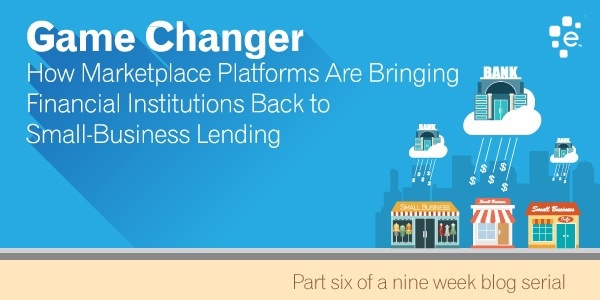
In the wake of the Great Recession, numerous entrepreneurs began to use online lending platforms to offer capital funding programs, short-term loans and other business-to-business (B2B) credit plans to small-business owners who were otherwise unable to do business with traditional banks. Today, much has changed, and “marketplace lending” has grown with loans coming in a wide variety of types, sizes, lengths and terms. The characteristics marketplace lenders tend to share include:
- An easy application process facilitated by Web-based platforms
- Fast approvals, often within 24–48 hours
- Higher-than-normal Annual Percentage Rates to compensate for the market’s higher risks
- The absence of state or federal regulation
The borrowers also share similar characteristics:
- They are often small, relatively young companies (between one and five years in business)
- Many are retailers, such as stores and restaurants, or B2B service companies, such as marketing and advertising agencies
- They have strong cash flow
As an industry, marketplace lending has enjoyed considerable success over the past five years. In some entrepreneurial circles, names such as Lending Club, Fundera, Creditera and Funding Circle are as well-known as Citibank, Bank of America and Wells Fargo. According to a recent report from Morgan Stanley, in 2014 marketplace lenders issued a combined $12 billion in loans in the United States and more than $24 billion worldwide. Morgan Stanley expects that activity to grow to $122 billion and $280 billion, respectively, by 2020.
Granted, such numbers are modest compared to the $15 trillion controlled by the total U.S. financial sector, but the market is large, fast-growing and has gained the attention of many “traditional” financial institutions. Many full-service banks see these newer online platforms as opportunities to increase their own efficiencies as well as a way to capture future long-term customers.
Union Bank Partners With Lending Club to Expand Opportunities
MUFG Union Bank N.A, a large financial institution that operates 398 full-service branches throughout California, Oregon and Washington, recently partnered with Lending Club, the San Francisco–based peer-to-peer lending company founded in 2006.
“Our relationship started as an investment,” said Donald Stroup, Chief Credit Officer for MUFG Union Bank N.A. Retail Banking group. “We have not been in the credit card business for many years and have had no exposure in auto finance or student lending. Lending Club offered us an opportunity for diversification, for expanding our banking services and for products that could help us broaden our household penetration.”
James Francis, Executive Vice President for MUFG Union Bank, N.A. Consumer Lending Group, also noted, “Online lenders are still very small players relative to the overall market, but they’re growing fast. Banks have a great deal of flexibility when it comes to working with marketplace lenders. Investors, such as banks, can pick and choose where they want to play; for example, we decided to purchase high-end consumer paper from Lending Club. Because it operates throughout the United States, we can purchase from Texas and New York, and not just the West Coast. Lending Club is very transparent with its criteria, so we know where the loans originate.”
Both Francis and Stroup believe that full-service banks can learn from marketplace lenders when it comes to speed, convenience and electronic applications. This is particularly true when it comes to working with millennials, many of whom are far more comfortable with the online environment than they are with brick-and-mortar establishments.
“Businesses may begin by shopping for cheap loans online, but once a business reaches a certain size and complexity, it looks to one provider to handle all its needs,” Francis added. “In addition to simple capital lending, this can include cash management, investments, liquidity, stock ownership plans, estate planning, etc. Online marketplace lending companies can’t provide that broad array of services and relationships. It takes a traditional bank to do that.”
While acknowledging the success marketplace lenders have had connecting with a segment of the market that for a time was underserved, Francis remains concerned about its resilience and longevity.
“This is still a largely untested business model,” he noted. “Having been born out of the Great Recession, marketplace lending hasn’t gone through a complete business cycle. It will be interesting to see how these lenders perform in a down cycle. I suspect that, in a down market, these lenders will have a harder time funding loans. Investors may get skittish when they see the lower returns that will inevitably occur.”
Despite their concerns, both Stroup and Francis remain open to exploring further opportunities in marketplace lending.
MUFG Union Bank N.A. is just one of many large financial institutions now exploring partnerships with online lending concerns. We expect these alliances to become increasingly common over the next two to three years, with new synergies creating more markets and opportunities, for borrowers and lenders alike.
Related articles
Just how alternative are today’s online marketplace lenders?
How online marketplace lenders are changing the rules of small-business finance
Self-Regulatory Program for Nonbank Small Business Lenders
Top regulatory priorities for commercial lenders
Playing to Your Strength – Opportunities for Regional Banks to Build Better Lending Portfolios
Game Changer – How Marketplace Platforms Are Bringing Financial Institutions Back to Small-Business Lending
Marketplace Matchmakers – How Loan Aggregators Bring Borrowers and Lenders Together
New Frontiers – What’s Next For Marketplace Lending?
